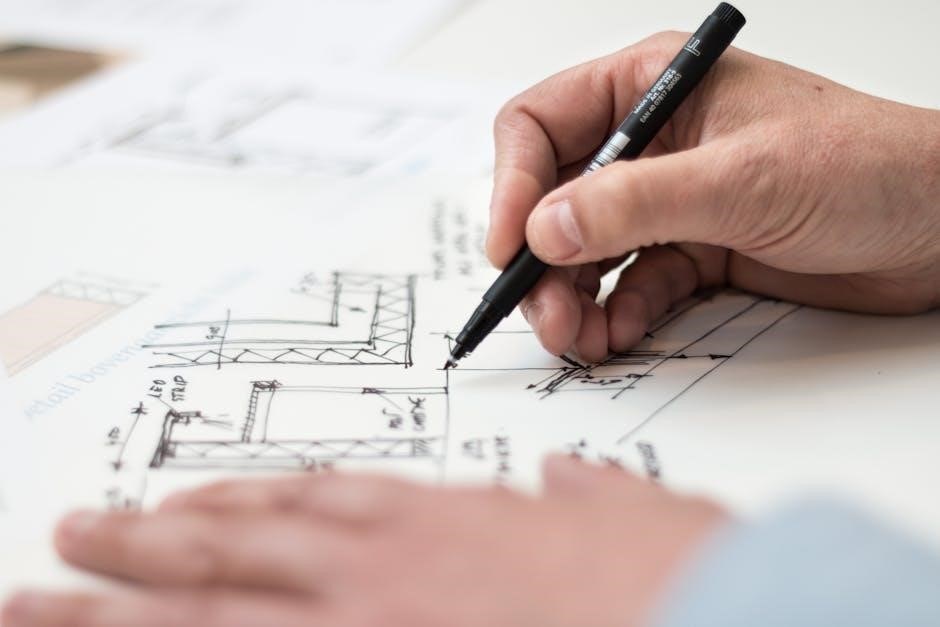Architect lettering guide provides essential skills for designers and architects to create uniform and legible drawings using specific techniques and tools in their daily work and projects effectively always.
Definition and Purpose of Architect Lettering
Architect lettering refers to a specific style of handwriting used by architects and designers to create uniform and legible drawings and documents. The purpose of architect lettering is to ensure that all text on blueprints, drawings, and designs is easy to read and understand, avoiding costly mistakes and miscommunications. This style of lettering has been established over centuries and is still widely used today in the fields of architecture and design. The use of architect lettering promotes consistency and clarity in communication among designers, architects, and contractors, making it an essential skill for anyone involved in the design and construction process. By using a standardized lettering style, architects and designers can effectively convey their ideas and intentions, ensuring that their designs are accurately interpreted and executed. The definition and purpose of architect lettering are deeply rooted in the need for clear and effective communication in the design and construction industry.

History of Architect Lettering
Architect lettering originated centuries ago to establish uniformity in drawings and documents using specific techniques and tools always and effectively.
Evolution of Architect Lettering Over Time
The evolution of architect lettering has been a gradual process, with various techniques and tools being introduced over the years to improve the quality and legibility of drawings and documents.
Initially, architect lettering was done by hand, with draftsmen using pens and pencils to create uniform and consistent letters and symbols.
With the advent of technology, new tools and software were developed to aid in the creation of architect lettering, such as computer-aided design (CAD) programs and graphic design software.
These tools have enabled architects and designers to create complex and detailed drawings with ease and precision, while also maintaining the traditional principles of architect lettering.
Today, architect lettering continues to play an important role in the field of architecture and design, with many schools and institutions still teaching the fundamentals of traditional architect lettering alongside modern computer-aided design techniques.

Importance of Consistency in Architect Lettering
Consistency in architect lettering ensures uniformity and clarity in drawings and documents always using specific techniques.
Techniques for Achieving Consistency in Architect Lettering
Techniques for achieving consistency in architect lettering involve using a grid to ensure uniform height, width, and angles of letters. This method helps to create unity and style in architectural drawings and documents. By practicing lettering using a grid, architects and designers can develop muscle memory and improve their skills. Additionally, using guidelines and templates can also help to achieve consistency in lettering. It is essential to use the same lettering style throughout a project to maintain clarity and readability; Consistency in lettering also helps to avoid mistakes and misinterpretations, which can be costly and time-consuming to correct. By mastering techniques for achieving consistency in architect lettering, architects and designers can produce high-quality drawings and documents that effectively communicate their ideas and designs. This, in turn, can help to improve collaboration and communication among team members and stakeholders. Effective communication is critical in architecture and design projects.
Technical Drawing Techniques for Architect Lettering
Technical drawing techniques involve using rulers and drafting tools to create precise letters and lines always with great accuracy and skill in architectural drawings and designs effectively every time.
Tools and Materials Needed for Architect Lettering
To create uniform and legible architectural drawings, specific tools and materials are required, including a range of pens, pencils, and markers with different line widths and tips, as well as a variety of paper types and textures.
A drafting table or a large, flat surface is also necessary for creating precise drawings and letters, and a set of rulers, triangles, and other geometric shapes can be used to draw straight lines and angles.
Additionally, a grid paper or a template with guidelines can help to achieve consistency and accuracy in lettering and drawing, and a good quality eraser and correction fluid are essential for correcting mistakes and making changes.
A comfortable and ergonomic chair, a good lighting system, and a quiet workspace are also important factors to consider when working on architectural drawings and lettering.
By having the right tools and materials, architects and designers can create high-quality drawings and letters that effectively communicate their ideas and designs.
The choice of tools and materials can also depend on the specific requirements of the project and the personal preferences of the designer.
Overall, the right tools and materials are essential for creating professional-looking architectural drawings and lettering.

Architect Lettering in Modern Architecture and Design
Modern architecture and design incorporate lettering in various forms and styles to enhance visual appeal and communication effectively always using digital tools and software.
Applications of Architect Lettering in Different Fields
Architect lettering has various applications in different fields, including architecture, design, and engineering. The use of uniform lettering styles enables effective communication among professionals and ensures that drawings and plans are easily understandable. In the field of architecture, lettering is used to label and describe different components of buildings and structures. It is also used in urban planning to create maps and diagrams that illustrate the layout of cities and towns. Additionally, architect lettering is used in landscape design to create plans and drawings of outdoor spaces. The use of consistent lettering styles in these fields helps to maintain clarity and precision, which is essential for successful project execution. Furthermore, architect lettering is used in educational institutions to teach students about different design and architectural concepts. Overall, the applications of architect lettering are diverse and continue to play a crucial role in various fields.


